A Novel Approach for Aircraft Engine Modeling Considering the Energy Accumulation Effect Based on a Variable Mass System Thermodynamics Method
Abstract
1. Introduction
2. Engine System Architecture
2.1. Engine Architecture
- (1)
- The gas flow in the engine is treated as one-dimensional flow, and the inlet and outlet airflow parameters of each component are represented by the average value;
- (2)
- Neglecting the impact of combustion lag;
- (3)
- Neglecting solid wall heat transfer;
- (4)
- Neglecting the viscous and inertial forces of gases.
2.2. Component Thermodynamic Model
- (1)
- Compressor
- (2)
- Combustor
- (3)
- Turbine
- (4)
- Nozzle
3. Engine Model with the Variable Mass Approach
3.1. Constant Mass Flow Method
3.2. Volume Dynamic Method
3.3. Variable Mass Method
4. Results and Discussion
4.1. Verification of Steady-State Simulation Accuracy of Variable Mass Method
4.2. The Impact of Energy Storage on Instantaneous-Change-State Simulation
5. Conclusions
- (1)
- The variable mass method significantly enhances simulation speed, achieving a rate approximately 28 times faster than that of the constant mass flow method based on the Newton–Raphson iterative solution. Moreover, the results are within a reasonable error range when compared with GASTURB data, verifying its accuracy and rapidity.
- (2)
- Compared with the traditional volume dynamic method, the variable mass method accounts for the energy storage effect of large-volume components. When there are dramatic changes in flight speed in a short time, the flow and energy storage within the volume chamber can be calculated. In the first acceleration process simulated in this article, the average flow error was reduced by 68.3%, and errors of up to 0.473 s in time delay and up to 0.66% in energy were eliminated. In the second acceleration process, the average flow error was reduced by 60.6%, and an error of up to 0.624 s in time delay was eliminated. Both simulation processes of the variable mass method further improved the accuracy of dynamic simulation. The approach is a feasible and innovative method for engine dynamic simulation and is of great significance for the simulation of relevant subsystems.
Author Contributions
Funding
Data Availability Statement
Acknowledgments
Conflicts of Interest
Abbreviations
| Nomenclature | Greek symbols | ||
| CM | control mass | efficiency | |
| CV | control volume | pressure ratio | |
| Subscripts | |||
| component number of the engine | |||
| power, | high-pressure | ||
| high-pressure compressor | |||
| high-pressure turbine | |||
| time constant, | low-pressure | ||
| temperature, | low-pressure compressor | ||
| low-pressure turbine | |||
References
- Evans, A.; Follen, G.; Naiman, C.; Lopez, I. Numerical Propulsion System Simulation’s National Cycle Program. In Proceedings of the 34th AIAA/ASME/SAE/ASEE Joint Propulsion Conference and Exhibit, Cleveland, OH, USA, 13–15 July 1998. [Google Scholar]
- DeCastro, J.; Litt, J.; Frederick, D. A modular aero-propulsion system simulation of a large commercial aircraft engine. In Proceedings of the 44th AIAA/ASME/SAE/ASEE Joint Propulsion Conference & Exhibit, Hartford, CT, USA, 21–23 July 2008. [Google Scholar]
- Sadaf, M.; Zeb, M.K.; Salamat, S.; Naqvi, M.A. Sensitivity and Design Point Analysis of RD-93 Engine at Static Sea Level using Numerical Propulsion System Simulation. In Proceedings of the 2020 3rd International Conference on Computing, Mathematics and Engineering Technologies (iCoMET), Sukkur, Pakistan, 29–30 January 2020. [Google Scholar]
- Otkur, M. Altitude Performance and Fuel Consumption Modelling of Aircraft Piston Engine Rotax 912 S/ULS. J. Adv. Res. Appl. Sci. Eng. Technol. 2021, 23, 18–25. [Google Scholar] [CrossRef]
- Aygun, H.; Cilgin, M.E.; Ekmekci, I.; Turan, O. Energy and performance optimization of an adaptive cycle engine for next generation combat aircraft. Energy 2020, 209, 118261. [Google Scholar] [CrossRef]
- Huang, C.; Cheng, X. Estimation of aircraft fuel consumption by modeling flight data from avionics systems. J. Air Transp. Manag. 2022, 99, 102181. [Google Scholar] [CrossRef]
- Ren, L.-H.; Ye, Z.-F.; Zhao, Y.-P. A modeling method for aero-engine by combining stochastic gradient descent with support vector regression. Aerosp. Sci. Technol. 2020, 99, 105775. [Google Scholar] [CrossRef]
- Pang, S.; Li, Q.; Zhang, H. A new online modelling method for aircraft engine state space model. Chin. J. Aeronaut. 2020, 33, 1756–1773. [Google Scholar] [CrossRef]
- Chen, Q.; Sheng, H.; Li, J.; Liu, T. Model-Based Improved Advanced Adaptive Performance Recovery Control Method for a Commercial Turbofan Engine. IEEE Trans. Aerosp. Electron. Syst. 2023, 59, 7440–7454. [Google Scholar] [CrossRef]
- Chen, J.; Hu, Z.; Wang, J. Aero-Engine Real-Time Models and Their Applications. Math. Probl. Eng. 2021, 2021, 9917523. [Google Scholar] [CrossRef]
- Xiang, S.; Qin, Y.; Luo, J.; Pu, H.; Tang, B. Multicellular LSTM-based deep learning model for aero-engine remaining useful life prediction. Reliab. Eng. Syst. Saf. 2021, 216, 107927. [Google Scholar] [CrossRef]
- Zhao, K.; Jia, Z.; Jia, F.; Shao, H. Multi-scale integrated deep self-attention network for predicting remaining useful life of aero-engine. Eng. Appl. Artif. Intell. 2023, 120, 105860. [Google Scholar] [CrossRef]
- Yildirim Dalkiran, F.; Toraman, M. Predicting thrust of aircraft using artificial neural networks. Aircr. Eng. Aerosp. Technol. 2021, 93, 35–41. [Google Scholar] [CrossRef]
- Fawke, A.; Saravanamuttoo, H.I. Digital Computer Methods for Prediction of Gas Turbine Dynamic Response; SAE Transactions; SAE International: Warrendale, PA, USA, 1971; pp. 1805–1813. [Google Scholar]
- Yang, Y.; Nikolaidis, T.; Jafari, S.; Pilidis, P. Gas turbine engine transient performance and heat transfer effect modelling: A comprehensive review, research challenges, and exploring the future. Appl. Therm. Eng. 2024, 236, 121523. [Google Scholar] [CrossRef]
- Nikolaidis, T.; Li, Z.; Jafari, S. Advanced Constraints Management Strategy for Real-Time Optimization of Gas Turbine Engine Transient Performance. Appl. Sci. 2019, 9, 5333. [Google Scholar] [CrossRef]
- Mansouri, H.; Ommi, F. Performance prediction of aircraft gasoline turbocharged engine at high-altitudes. Appl. Therm. Eng. 2019, 156, 587–596. [Google Scholar] [CrossRef]
- Liu, Z.; Huang, Y.; Gou, L.; Fan, D. A robust adaptive linear parameter-varying gain-scheduling controller for aeroengines. Aerosp. Sci. Technol. 2023, 138, 108319. [Google Scholar] [CrossRef]
- Ma, J.; Chang, J.; Ma, J.; Bao, W.; Yu, D. Mathematical modeling and characteristic analysis for over-under turbine based combined cycle engine. Acta Astronaut. 2018, 148, 141–152. [Google Scholar] [CrossRef]
- Sun, B.; Xu, Q.; Chen, Y. Dynamic modeling and simulation of a pressurized system used in flight vehicle. Chin. J. Aeronaut. 2018, 31, 1232–1248. [Google Scholar] [CrossRef]
- Jennions, I.; Ali, F.; Miguez, M.E.; Escobar, I.C. Simulation of an aircraft environmental control system. Appl. Therm. Eng. 2020, 172, 114925. [Google Scholar] [CrossRef]
- Xi, Z.; Zhang, H.; Chen, M.; Cai, C.; Wang, J. Design of thrust augmentation control schedule during mode transition for turbo-ramjet engine. Aerosp. Sci. Technol. 2023, 138, 108352. [Google Scholar] [CrossRef]
- Zheng, Q.; Wang, Y.; Jin, C.; Zhang, H. Aero-engine dynamic model based on an improved compact propulsion system dynamic model. Proc. Inst. Mech. Eng. Part I J. Syst. Control. Eng. 2021, 235, 1036–1045. [Google Scholar] [CrossRef]
- Gennady, G.; Kulikov, H.A.T. Dynamic Modelling of Gas Turbine: Identification, Simulation, Condition Monitoring and Optimal Control; Springer: Berlin/Heidelberg, Germany, 2004. [Google Scholar]
- Li, Y.; Xuan, Y. Integrated thermal modeling of helicopters. Appl. Therm. Eng. 2019, 154, 458–468. [Google Scholar] [CrossRef]
- Hu, Z.; Xuan, Y. Topology optimization of hydrogen-powered aviation hybrid systems via thermal management principles. Int. J. Hydrog. Energy 2024, 58, 1098–1113. [Google Scholar] [CrossRef]
- Sun, J.; Hoekstra, J.M.; Ellerbroek, J. OpenAP: An open-source aircraft performance model for air transportation studies and simulations. Aerospace 2020, 7, 104. [Google Scholar] [CrossRef]
- Liu, J.; Xu, M.; Guo, W.; Xi, W.; Liu, C.; Sunden, B. Flow and heat transfer mechanism of a regenerative cooling channel mounted with pin-fins using supercritical CO2 as coolant. Int. J. Therm. Sci. 2025, 208, 109425. [Google Scholar] [CrossRef]
- Wu, P.; Ma, Y. Thermodynamics of Variable Mass Systems and Applications; Higher Education Press: Beijing, China, 1983. (In Chinese) [Google Scholar]
- Luo, X.; Geng, J.; Li, M.; Liu, B.; Wang, L.; Song, Z. Research on Iterative Calculation and Optimization Methods of Aero-engine On-board Model. J. Syst. Simul. 2022, 34, 2649–2658. [Google Scholar]
- Wang, W. Development of Control and Simulation Platform for a Certain Type of Turbojet Engine; Nanchang University: Nanchang, China, 2022. (In Chinese) [Google Scholar]
- Eriksson, L.; Nielsen, L. Modeling and Control of Engines and Drivelines; John Wiley & Sons: Hoboken, NJ, USA, 2014. [Google Scholar]
- Chen, Q.; Huang, J.; Pan, M.; Lu, F. A Novel Real-Time Mechanism Modeling Approach for Turbofan Engine. Energies 2019, 12, 3791. [Google Scholar] [CrossRef]
- Jeschke, P.; Koschel, W.; Klumpp, C.; Weintraub, D. Teaching Aero-Engine Performance: From Analytics to Hands-On Exercises Using Gas Turbine Performance Software. J. Eng. Gas Turbines Power 2025, 147, 011015. [Google Scholar] [CrossRef]
- Kurzke, J.; Halliwell, I. Engine Model Examples, in Propulsion and Power: An Exploration of Gas Turbine Performance Modeling; Springer International Publishing: Cham, Switzerland, 2018; pp. 147–212. [Google Scholar]

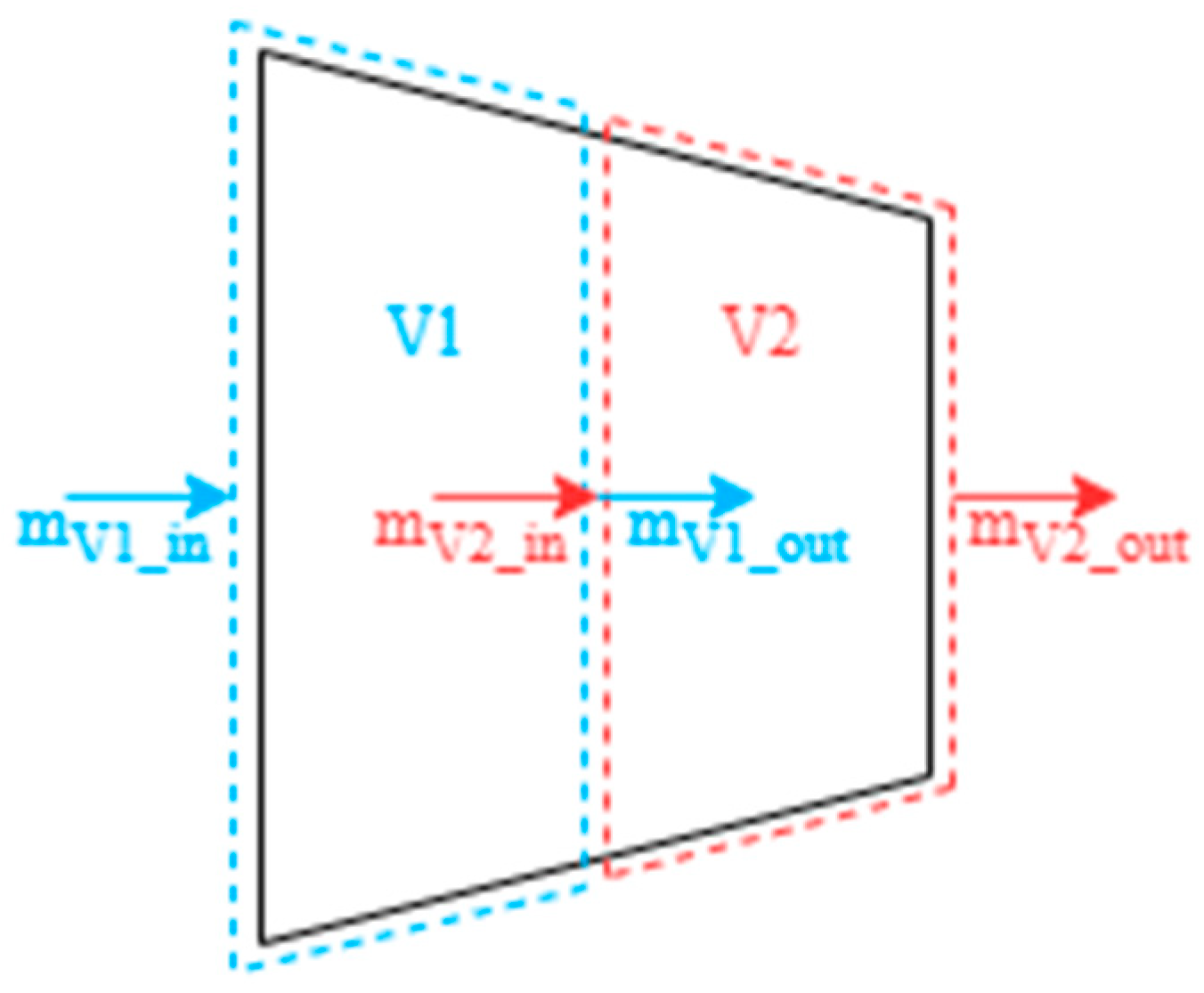
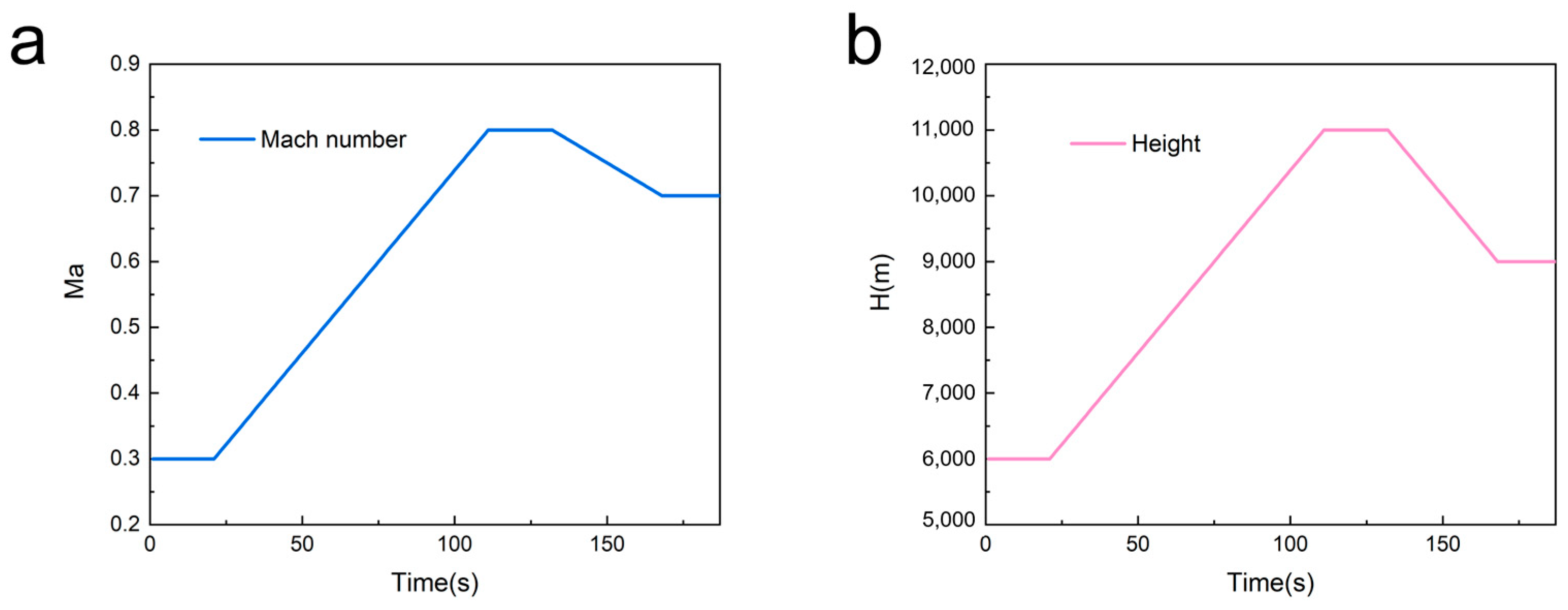
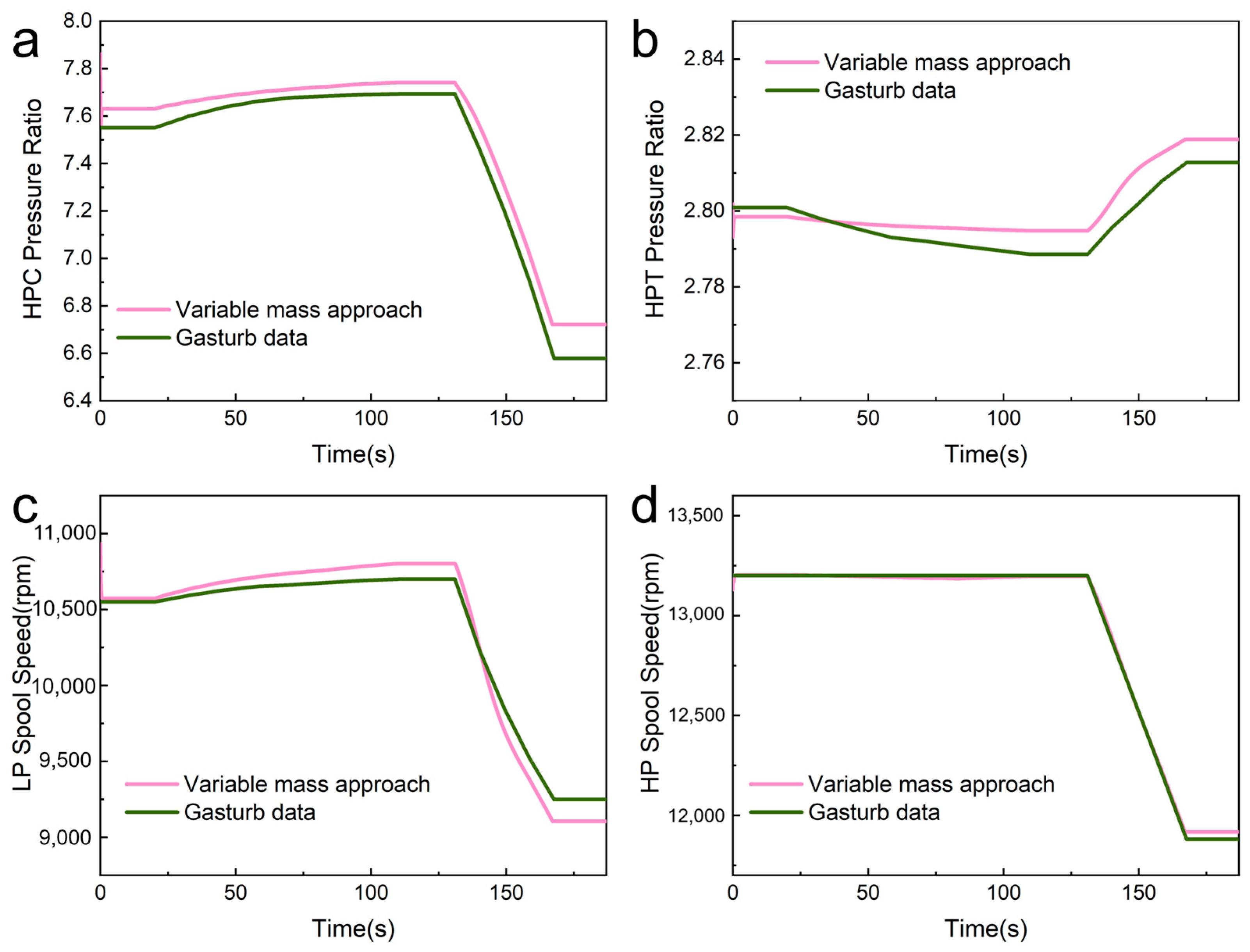
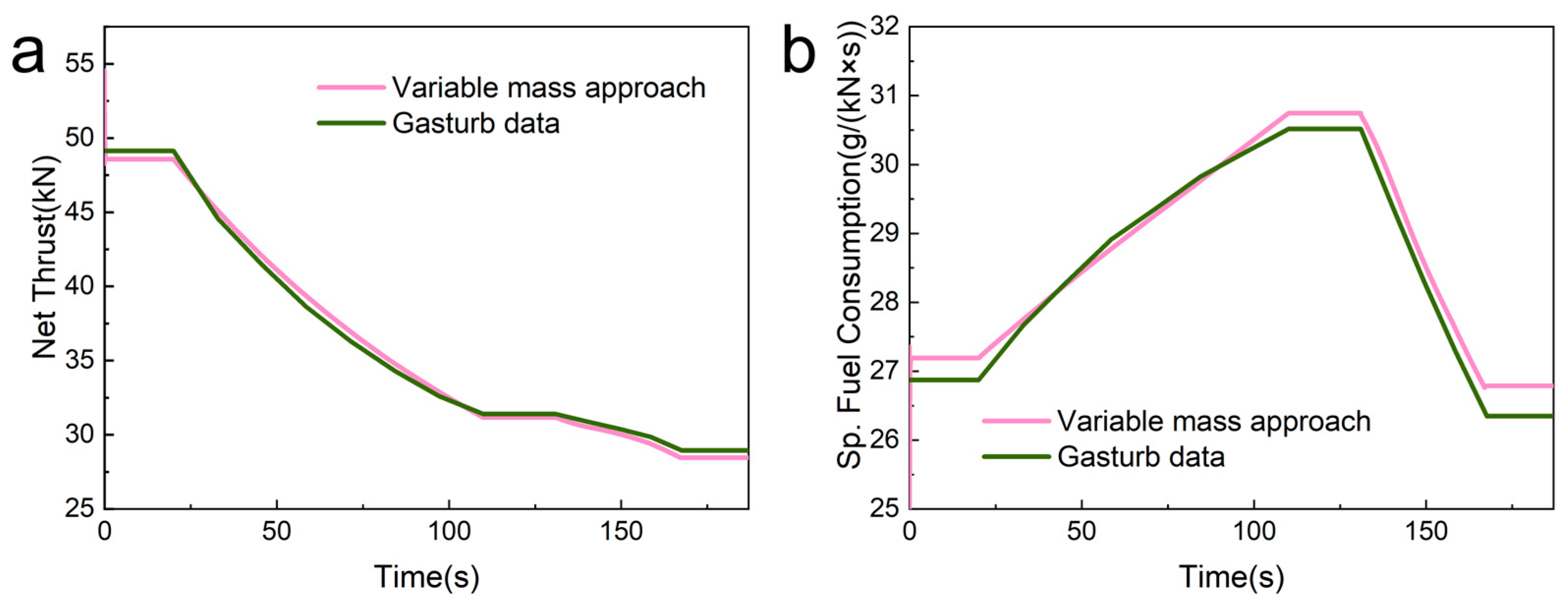
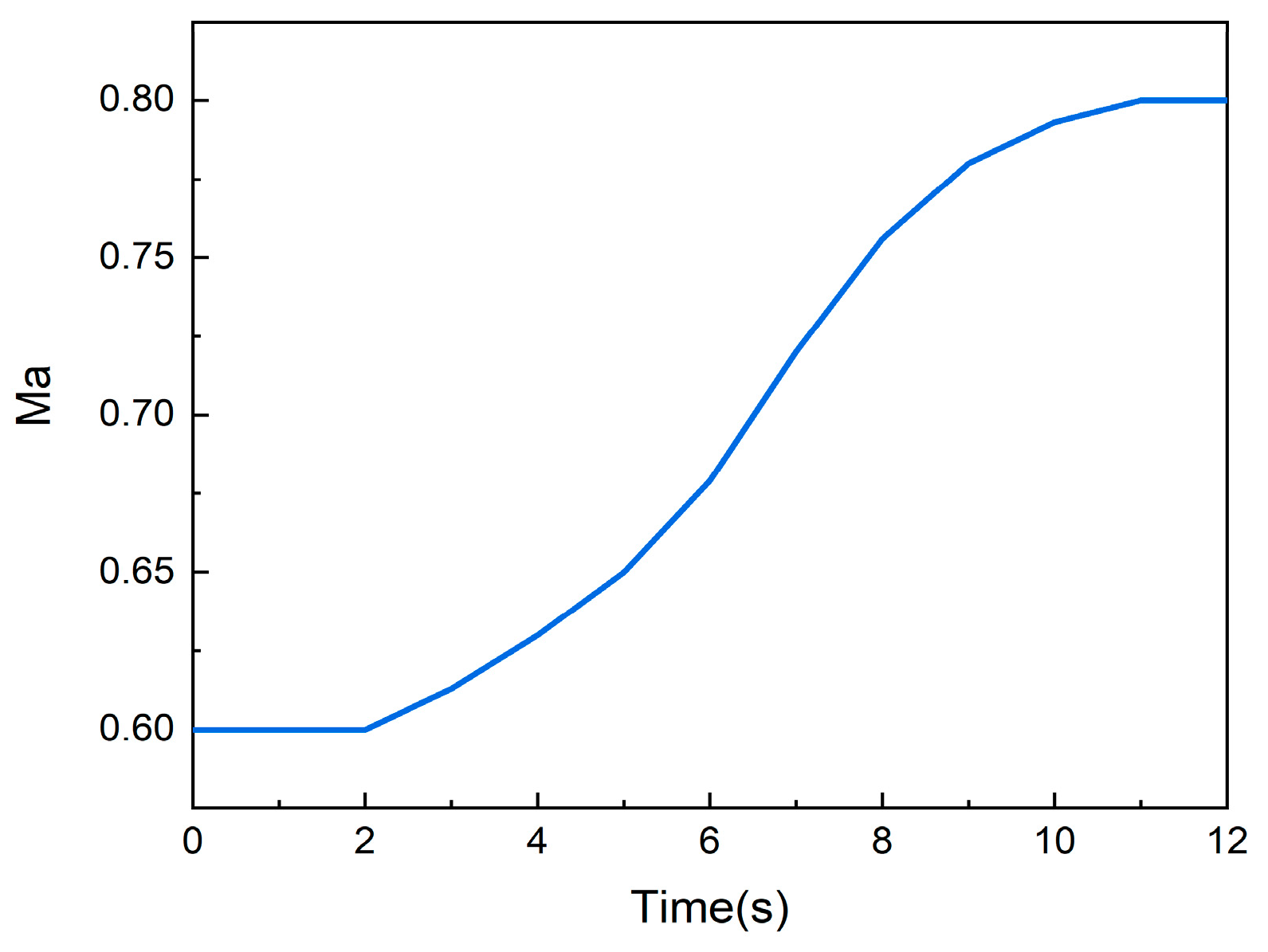
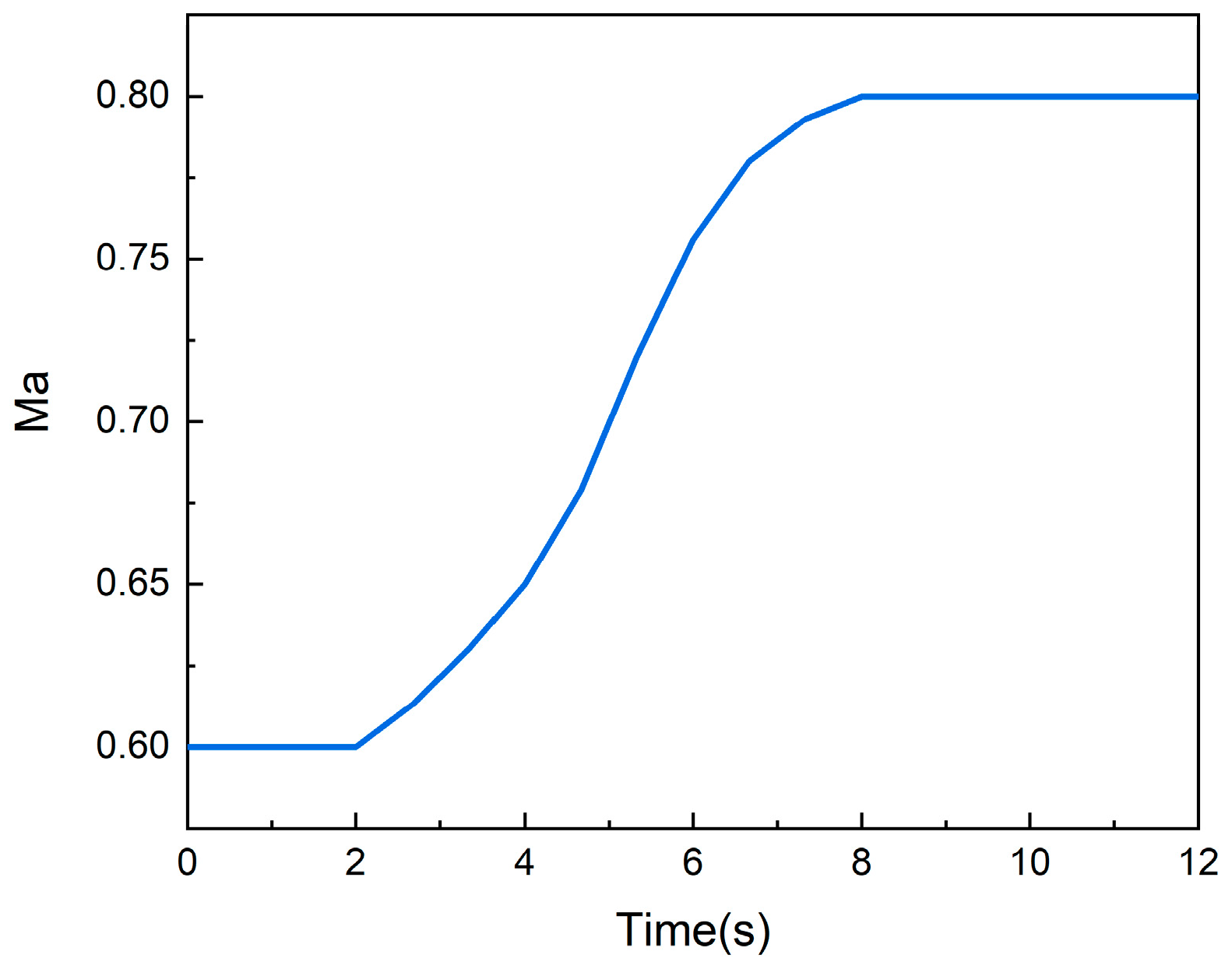
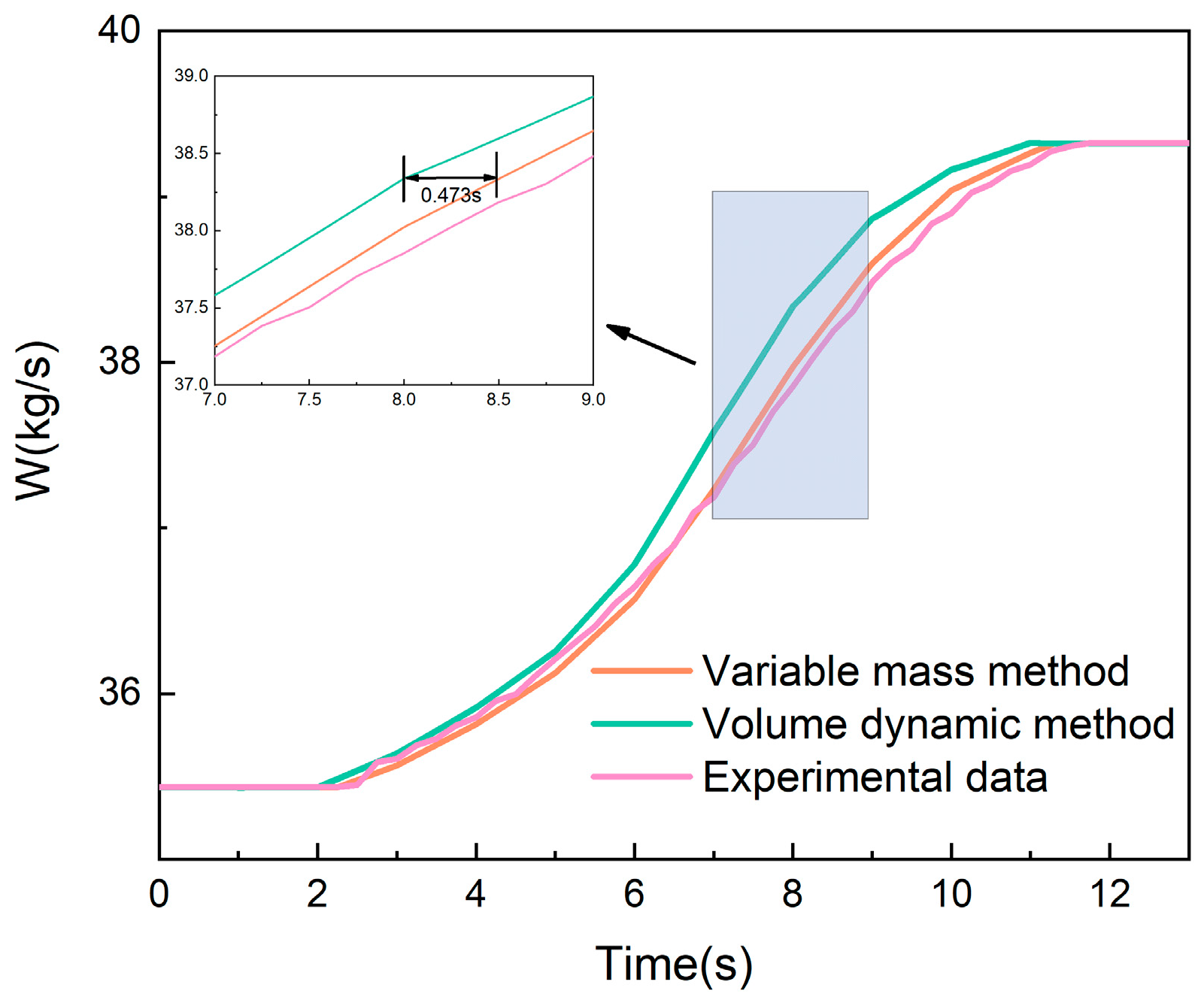

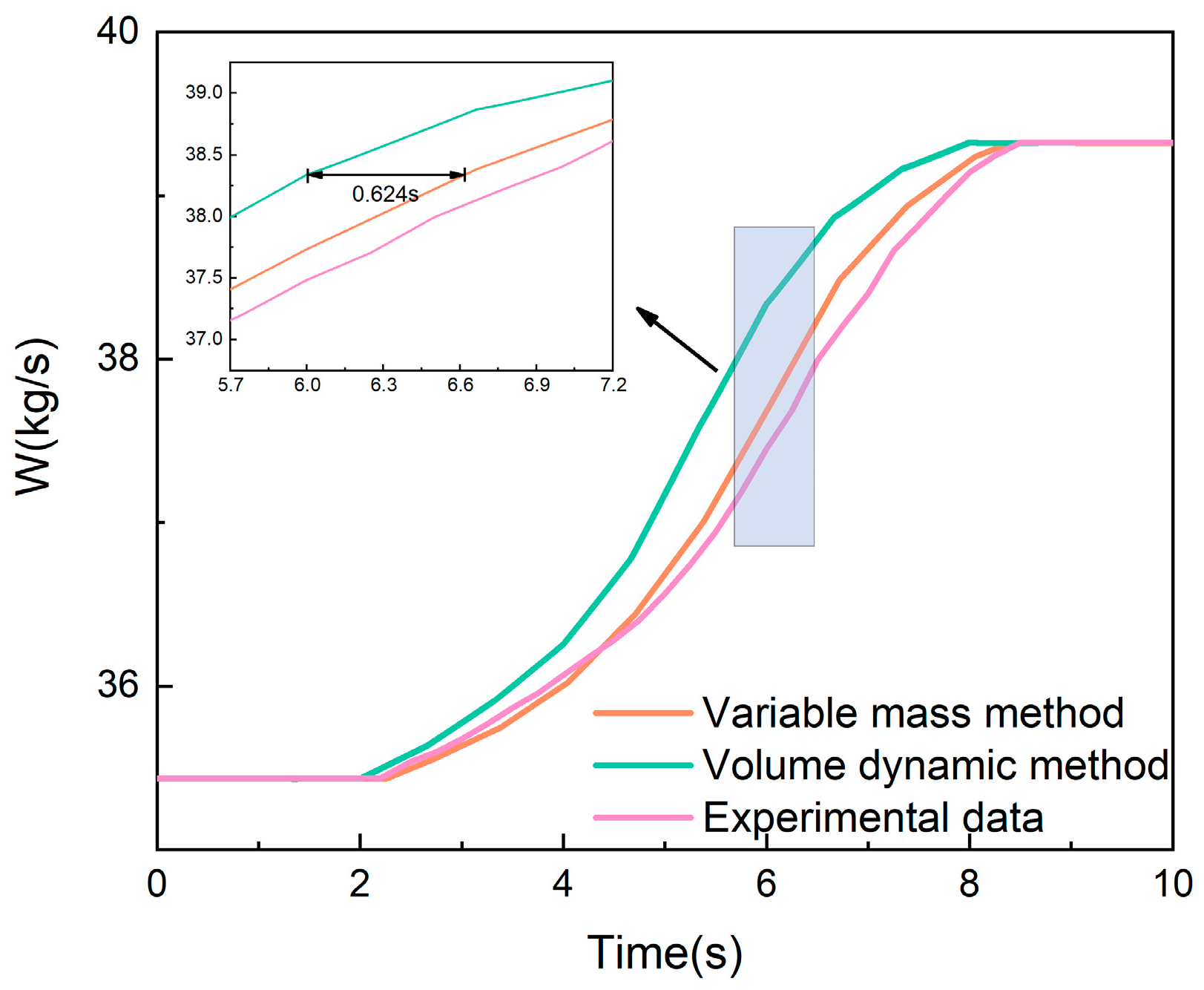
| Designed Parameters | Value |
|---|---|
| High-pressure (HP) spool speed (rpm) | 13,200 |
| Low-pressure (LP) spool speed (rpm) | 10,324 |
| Shaft mechanical transmission efficiency | 0.99 |
| Inlet flow rate (kg/s) | 99 |
| Inlet total pressure recovery factor | 0.99 |
| Low-pressure compressor pressure ratio | 4.000 |
| Low-pressure compressor isentropic efficiency | 0.85 |
| Total pressure loss between high and low compressors | 0.98 |
| High-pressure compressor (HPC) pressure ratio | 7.000 |
| High-pressure compressor isentropic efficiency | 0.86 |
| Combustor relative pressure loss | 0.97 |
| Combustion efficiency | 0.99 |
| Lower heating value of fuel (kJ/kg) | 43,124 |
| Fuel flow (kg/s) | 2.3114 |
| High-pressure turbine (HPT) pressure ratio | 2.806 |
| High-pressure turbine isentropic efficiency | 0.90 |
| Total pressure loss between high and low turbine | 0.98 |
| Low-pressure turbine pressure ratio | 1.658 |
| Low-pressure turbine isentropic efficiency | 0.91 |
| Total pressure loss between low-pressure turbine and nozzle | 0.98 |
| Nozzle throat area (m2) | 0.1671 |
| Nozzle total pressure recovery factor | 0.98 |
| Nozzle discharge coefficient | 0.95 |
| Method | Constant Mass Flow Method | Volume Dynamic Method | Variable Mass Method |
|---|---|---|---|
| Time (min) | 165 | 5.8 | 5.8 |
Disclaimer/Publisher’s Note: The statements, opinions and data contained in all publications are solely those of the individual author(s) and contributor(s) and not of MDPI and/or the editor(s). MDPI and/or the editor(s) disclaim responsibility for any injury to people or property resulting from any ideas, methods, instructions or products referred to in the content. |
© 2024 by the authors. Licensee MDPI, Basel, Switzerland. This article is an open access article distributed under the terms and conditions of the Creative Commons Attribution (CC BY) license (https://creativecommons.org/licenses/by/4.0/).
Share and Cite
Dong, H.; Lian, W. A Novel Approach for Aircraft Engine Modeling Considering the Energy Accumulation Effect Based on a Variable Mass System Thermodynamics Method. Energies 2024, 17, 6424. https://doi.org/10.3390/en17246424
Dong H, Lian W. A Novel Approach for Aircraft Engine Modeling Considering the Energy Accumulation Effect Based on a Variable Mass System Thermodynamics Method. Energies. 2024; 17(24):6424. https://doi.org/10.3390/en17246424
Chicago/Turabian StyleDong, Huazhao, and Wenlei Lian. 2024. "A Novel Approach for Aircraft Engine Modeling Considering the Energy Accumulation Effect Based on a Variable Mass System Thermodynamics Method" Energies 17, no. 24: 6424. https://doi.org/10.3390/en17246424
APA StyleDong, H., & Lian, W. (2024). A Novel Approach for Aircraft Engine Modeling Considering the Energy Accumulation Effect Based on a Variable Mass System Thermodynamics Method. Energies, 17(24), 6424. https://doi.org/10.3390/en17246424






